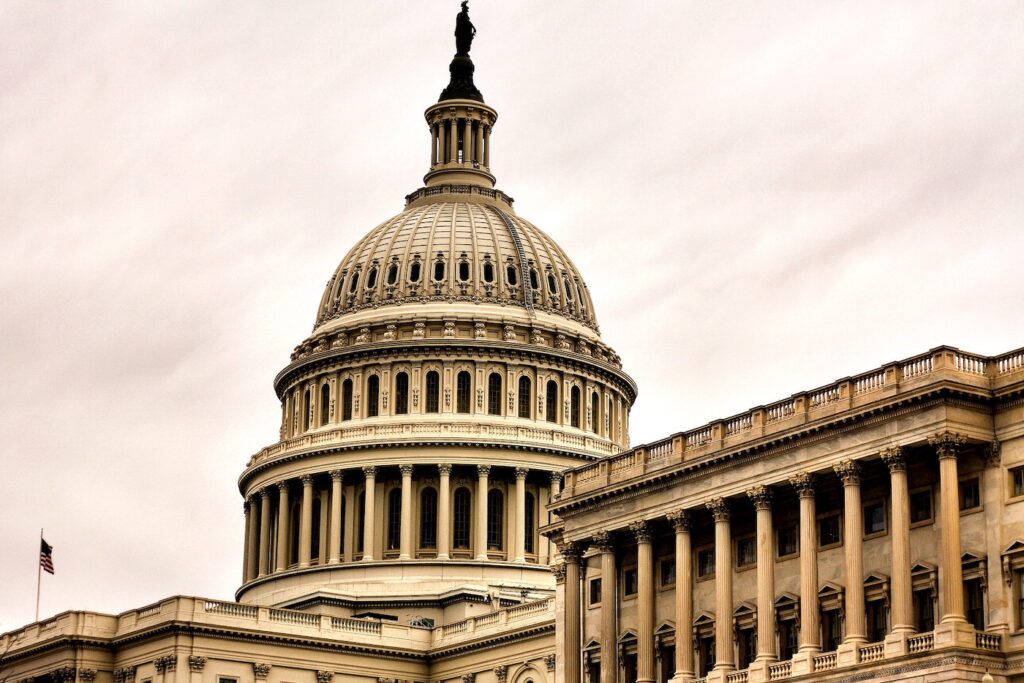My recent book Democracy in the Time of Coronavirus argues for what political scientist Lisa Miller, in her review in these pages, dubs “aspirational federalism.” I like and will embrace this label.
For the most part, public discourse about federalism swings between two extremes. On one side, there is a picture of federalism as states rights, according to which the point of federalism is that states get to do whatever they want. This is the conception of federalism that the right has made prominent. It’s also the conception of federalism that animated the Articles of Confederation, led to the dysfunction of that system of government, and motivated the Constitutional convention in 1787. On the other extreme, there is a picture of federalism as best being replaced by a system of strong national power and a government that is unitary in practice, if not in name, because states cannot be trusted to protect the rights of minorities. This is the picture that emerged on the left in the wake of the need to break the power of segregationist legal regimes in Southern states.
Against both of these extremes, I outline a vision for federalism that, as in the Constitutional Convention, tips to the national and lodges key powers at the national level, yet also recognizes that legislative decision-making at subnational jurisdictional levels is necessary for issues and challenges that aren’t best scaled up to the national level. In my case, I tip to the national in order to guarantee the protection of minorities across all jurisdictions. Aspirational federalism also tips to the national to assign authority and responsibility to drive harmonization of policy across jurisdictions. In legal terms, the name for this method of harmonization is “collaborative” federalism: the federal government sets standards and goals, and then empowers their delivery, through both funding and the distinctive capacity of a national government—enabled by a bird’s eye view perspective—to spur strategic coordination across jurisdictions.
In particular, the vision of aspirational federalism I defend has five elements:
- national power has among its rights and responsibilities the job of steering harmonization across jurisdictional levels (federal, state, regional, county, and municipal);
- rights and responsibilities for the national power include the authority and competencies to ensure equal protection of the laws and access to a republican form of government for all;
- public recognition exists that will-formation (and therefore legislative direction-setting) will forever be necessary at different jurisdictional levels in order to tackle the full diversity of collective action problems and the different scales at which they emerge; consequently will-formation cannot simply be concentrated at a single national level;
- legitimate methods exist for revisiting over time which collective action problems should be the subject of national will-formation (and national legislative direction-setting), and which should be the subject of state, county, or municipal will-formation and legislative direction-setting; the exception to revisability would be that the requirement to ensure equal protection of the laws and access to a republican form of government cannot be moved from the national level to a subsidiary level; and
- the combined tools of federalism achieve a fusion of inclusion and effectiveness in governance and decision-making.
Miller is skeptical about this collaborative or aspirational federalism on two fronts. First, she does not believe it characterizes the operations of U.S. federalism as they currently operate. There I concur. If my aspirational picture of the elements of a desirable federalism feels unfamiliar, that’s because it is. The vision is indeed aspirational. It was motivated by my observation of the absence of such a pattern of harmonization during the COVID-19 period of 2020 and 2021, under both the Trump and Biden administrations.
Yet even more importantly, Miller also takes the logic of the U.S. federal system to undermine the existence and competencies of national power, by definition. As she sees it, any expectation that will-formation and independent legislative direction-setting will occur via the self-governing bodies of states necessarily undermines a stable and effective national power, with the consequence of making this framework for federalism both logically and practically incoherent.
Subscribe to our newsletter to get our latest essays, archival selections, and exclusive editorial content in your inbox.
Here I disagree. Miller is right that the permanent revisability of decisions about the jurisdictional level where specific categories of policy should be enacted does make for ongoing contestation between national and state powers, even with the exceptions removing equal protection and access to a republican form of government from that revisability. But the permanence of contestation need not undermine the capacity of the national government to drive harmonization. As Miller would acknowledge, the national government has resources that the state governments do not have. That difference can tip the balance of power in the national government’s favor: a national tax base, a fiscal policy that can include deficits and monetary policy, and a national, birds’-eye view knowledge base. These resources permit the federal government to structure the context in which states operate and ought to enable the federal government to drive harmonization of policy across the country.
The tools to achieve this harmonization are not those that we normally think of when we think about policymaking. In the COVID-19 pandemic, one of the clear challenges has lain in getting healthy and safe in-person learning going again for the nation’s public schools. My research team worked on this consistently and steadily from June 2020 through August 2021. In those early months, we observed an extraordinary situation: no one at any jurisdictional level seemed to have a clear grasp of who should be doing what. Ultimately, in order to support coordination of effort, we created a RAECI chart for the nation’s education system to support decision-making. The acronym stands for Responsible-Accountable-Engaged-Consulted-Informed. On charts of this kind, one maps out for any given project who the responsible party is, who the accountable party is, who needs to be engaged, who needs to be consulted, who simply needs to be informed. Charts like this help people coordinate efficiently. You can find our RAECI chart in the appendix to our Roadmap to Healthy Schools.
In this instance, we didn’t nail down every single detail of who would be doing what. The jurisdictional structures of our states are too various for that. But we did indicate what kinds of decisions needed to be made about how to assign those roles. Ultimately, our Roadmap and the RAECI chart were distributed to state departments of education all over the country. We were filling a clear and debilitating gap. In the 1960s an infrastructure for coordinating across jurisdictions was built, but the several decades-long project of shrinking government has led to its withering away. This erosion of capacity mirrors the erosion of congressional research capacity in the wake of the 1994 Contract with America budget cuts.
The federal government could itself more generally renew its capacity to fill this sort of gap in alignment with the new model of federalism I sketch here, supporting states in effective decision-making while also leaving space for the states to make context-specific decisions. To think of a tool like a RAECI chart as an instrument of federalism is, I think, a fundamentally new approach; it illustrates what I have in mind by harmonization. A second model of the collaborative federalism organized around a principle of harmonization can be found in the Educating for American Democracy Roadmap. Here, too, federal policy is called on to provide a framework of structured choice for states and to support state action within that framework with resources.
I believe that getting federalism right has to be one of our most important tasks for coming to grips with how to achieve massive-scale, multicultural democracies. As a society, we are undertaking an evolution of liberalism. The liberalism of the late eighteenth century was partial. Even as it trumpeted the language of human rights and self-government for free and equal citizens, that early liberalism restricted participation, for the most part, to men with property and, more specifically, white men with property. Even as the franchise was extended—reaching women in Switzerland only in the 1970s—the evolving liberalisms of the nineteenth and twentieth century continued to treat democracy as an activity to be practiced in full primarily by the elite. Even after everyone got the vote, twentieth-century politics and policy making, and especially in the last few decades of the twentieth century, continued to be dominated by elite decision-making, in the form of technocracy.
Many have made the point that the fatal flaw in the liberalism of the eighteenth and nineteenth centuries was to think that rights could be thought protected for all when power was placed only in the hands of some. Historians Annette Gordon-Reed and Peter Onuf have written persuasively about how the principle of paternalism was built into the liberalism of the founding era. It is still built into the liberalism of the twenty-first century; it is built into technocracy. To achieve full liberation and freedom for all from domination instead requires achieving a liberalism truly based on power-sharing. Martin Luther King, Jr., put it especially well. In Testament of Hope (1986), he wrote:
Integration is meaningless without the sharing of power. When I speak of integration, I don’t mean a romantic mixing of colors, I mean a real sharing of power and responsibility. We will eventually achieve this, but it is going to be much more difficult for us than for any other minority.
In very large societies, we need to be able to make sure that real decision-making continues to scale down so that power truly can be shared. That requires devolution wherever possible. Miller rightly distinguishes devolution or decentralization from federalism: as she notes, “Federalism is often conflated with decentralization, but the two are not the same.” But devolution requires federalism in order that not only policy implementation but also direction-setting decision making may be shared throughout society, to the degree compatible with equal protection and protection of access to a republican form of government. Unitary states such as the United Kingdom and New Zealand deprive local and regional governments of the legal, constitutional sovereignty they need to share power, make direction-setting decisions, and, sometimes, contest national authority in the interest of improved cross-jurisdictional harmonization.
Devolution is necessary, then, but it is hardly enough in itself. The question of how to achieve the union of effective governance (the dream of technocrats) and participatory inclusion puts any number of challenging governance questions on the table. Among them is the original difficult question of which policy areas can be appropriately handled at the state level without doing harm to sub-populations. And then there are other questions at other jurisdictional levels about how to achieve governance that marries inclusion with the effective resolution of collective action problems. An example would be how decisions about zoning and housing can be structured to convert NIMBYism into YIMBYism. This is an area in which local participation has the effect not of solving collective action problems but of exacerbating them. On the model of aspirational federalism, the site of decision-making should move in such an instance up to a jurisdictional level at which it aligns with the collective action-problem to be solved—probably at the level of the state, not the municipality, for housing. At the state-level we should be able to achieve fair forms of inclusive governance that also effectively resolve collective action problems.
In the end, then, aspirational federalism points to many unanswered questions and a large research agenda. But such are the times we live in; we are called to do new things that haven’t been done before. Reimagining federalism is one of them.








